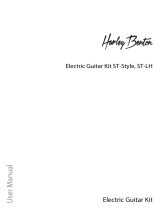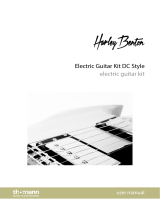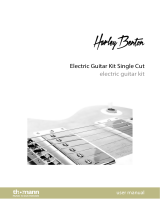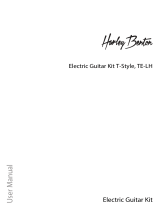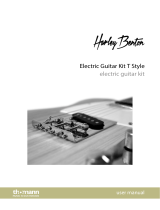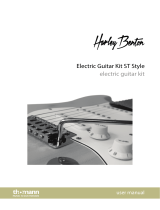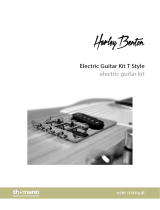Page is loading ...

Electric Guitar Kit HB35 Style
Electric Guitar Kit
User Manual

Thomann GmbH
Hans-Thomann-Straße 1
96138 Burgebrach
Germany
Telephone: +49 (0) 9546 9223-0
Internet: www.thomann.de
09.02.2023, ID: 549486

Table of contents
1 Safety instructions................................................................................................................. 5
2 Scope of delivery..................................................................................................................... 6
3 Assembly instructions.......................................................................................................... 7
3.1 Painting the body and neck........................................................................................ 7
3.2 Mounting the machine heads.................................................................................... 8
3.3 Mounting the guitar neck.......................................................................................... 10
3.4 Preparing for mounting the tailpiece and bridge............................................. 12
3.5 Wiring pots, pick-ups and switch............................................................................ 15
3.6 Mounting the tailpiece, bridge, strings, pickguard, belt pins and pot
knobs................................................................................................................................. 21
3.7 Neck relief and string action..................................................................................... 26
4 Protecting the environment........................................................................................... 29
Table of contents
Electric Guitar Kit HB35 Style 3
Electric Guitar Kit

4Electric Guitar Kit HB35 Style
Electric Guitar Kit

1 Safety instructions
DANGER!
Danger for children
Ensure that plastic bags, packaging, etc. are properly disposed of and
are not in the reach of babies and young children. Choking hazard!
Ensure that children do not detach any small parts (e.g. knobs or the
like) from the product. They could swallow the pieces and choke!
Never let children play unattended with the product.
CAUTION!
Risk of injury to the hands
When assembling and screwing the individual parts, pay attention to
sharp edges on tools, screws and components.
Safety instructions
Electric Guitar Kit HB35 Style 5
Electric Guitar Kit

2 Scope of delivery
Thank you for buying this electric guitar kit. All wooden parts, hardware and electrical
components are contained in this package.
The following gure shows the individual components of the delivery.
The assembly is described in detail in the following sections.
Scope of delivery
6Electric Guitar Kit HB35 Style
Electric Guitar Kit

3 Assembly instructions
Provide the following tools and materials for the assembly of the guitar:
nPhillips screwdriver
nRubber mallet
nRing wrench
nPliers
nVarnish and accessories
nSandpaper
It is essential that the body and neck are painted before assembly.
You must wear a dust mask when applying spray lacquer or paint.
3.1 Painting the body and neck
The solid wood of the guitar body is sealed and prepared for various types of lacquer
coating. A wide variety of nishes can be procured from DIY, timber and automotive
outlets in aerosol cans making nishing straightforward without requiring specialist
skills.
The rst step is to check the t of the body to neck joint. These parts are machined
from high-grade tone woods to ensure optimum alignment. However, wood is a nat‐
ural material that changes its shape slightly over time. If the neck is too tight in the
cutout on the body, you can rework the t with a sharp chisel or sandpaper. Please
keep in mind that the coating of lacquer will make the neck t a little more tightly
into the cutout.
Before coating the body, ensure that all surfaces are clean and free of dirt and dust.
Carry out all painting work in a well-ventilated, dust-free environment. Considered
and careful working is the key factor for ensuring a satisfactory result. It is highly rec‐
ommended that you rst try out the colour and technique on a dierent piece of
wood.
Paint the body edges rst and let them dry. If the edges are dry, continue with the
front and back. By layered, successive application you can achieve a uniform coating
structure. If you notice surface irregularities, wait until the paint has dried completely
and correct them with ne sandpaper (e.g. 800+) before proceeding to paint. Apply
three or more layers for full coverage.
Wait another two to three days to dry until the paint is fully cured. Polish or burnish
the body until it meets your expectations. Take care not to bu too vigorously as this
may remove the nish.
Useful tools and materials
Painting the body
Assembly instructions
Electric Guitar Kit HB35 Style 7
Electric Guitar Kit

The guitar neck is sealed with a thin layer of matt lacquer before delivery and is ready
to use. If you still want to treat the neck with coloured or clear lacquer, proceed as
described below.
Carefully mask o the ngerboard and all frets before painting. Make sure that all sur‐
faces are free of dust and dirt. Carry out all painting work in a well-ventilated, dust-
free environment.
For the neck, use a clear or slightly tinted wood paint of good quality. Start on the
front and at the edges of the headstock. Apply a thin layer evenly, let it dry and
repeat the process two or three times. If you notice surface irregularities, wait until
the paint has dried completely and correct them with ne sandpaper (e.g. 800+)
before proceeding to paint.
Once the headstock has dried, place the neck on the ngerboard and paint the back
of the neck as described.
Wait another two to three days to dry until the paint is fully cured. Polish or burnish
the neck until it meets your expectations. Take care not to bu too vigorously as this
may remove the nish.
3.2 Mounting the machine heads
Insert the four machine heads from the rear side of the headstock into the bores.
Align the machine heads so that the tuning pegs are perpendicular to the top of the
headstock.
Fix the machine heads as shown in the gure in this position hand-tight with the sup‐
plied screws.
Painting the neck
Assembly instructions
8Electric Guitar Kit HB35 Style
Electric Guitar Kit

Turn the neck over and x all machine heads hand-tight with the supplied washers
and nuts on the front of the headstock.
Tighten the nuts on the front with a suitable wrench, and then tighten the screws to
secure the machine heads on the rear side.
Assembly instructions
Electric Guitar Kit HB35 Style 9
Electric Guitar Kit

3.3 Mounting the guitar neck
Place the body on a suitable work surface. Use a soft pad to avoid damaging the sur‐
face. Fit the neck into the neck cutout. If necessary, use a sharp chisel or sandpaper
for reworking. Be very careful when removing material. The neck should be tight and
never have too much clearance in the cutout!
Assembly instructions
10 Electric Guitar Kit HB35 Style
Electric Guitar Kit

Turn the guitar over. First put on the rubber plate, then position the neck plate over
the four screw holes on the back of the body. Then screw the four long wood screws
provided through the holes in the neck plate, body and neck until everything ts
tightly.
Assembly instructions
Electric Guitar Kit HB35 Style 11
Electric Guitar Kit

3.4 Preparing for mounting the tailpiece and bridge
Thread the string-earthing cable (stripped, without connectors) through the channel
from the back hole into the tailpiece mounting hole.
Lead the cable out of the hole so that sucient contact with the metal surface can be
achieved when tting the tailpiece. String earthing reduces noise (buzzing).
Assembly instructions
12 Electric Guitar Kit HB35 Style
Electric Guitar Kit

Use a rubber mallet to drive the bolt fasteners for the tailpiece and bridge into the
body as shown. Make sure there is sucient contact between the stripped end of the
grounding cable and the tailpiece bolt.
Assembly instructions
Electric Guitar Kit HB35 Style 13
Electric Guitar Kit

Screw in the inserts and screws for the bridges and tailpiece as shown in the gure.
Assembly instructions
14 Electric Guitar Kit HB35 Style
Electric Guitar Kit

3.5 Wiring pots, pick-ups and switch
The pick-ups, potentiometer and jacks are connected to a cable harness with click-on
plugs. Prepare the neck pick-up (yellow cable) and the bridge pick-up for installation
by routing the cables through the recesses and then screwing in the pick-ups as
shown in the photo.
Assembly instructions
Electric Guitar Kit HB35 Style 15
Electric Guitar Kit

Plug the cable harness into the “F hole” and connect the click-on plugs to the poten‐
tiometers as shown in the gure. Usually the upper tone and volume potentiometers
are connected to the neck pick-up, and the lower tone and volume potentiometers
to the bridge pick-up. Then insert the potentiometer into the prepared holes on the
rear panel as shown in the following gure.
Assembly instructions
16 Electric Guitar Kit HB35 Style
Electric Guitar Kit

Assembly instructions
Electric Guitar Kit HB35 Style 17
Electric Guitar Kit

Insert the output jack into the hole provided on the edge of the body. Insert the
holder for the output jack and check the projection of the jack. This must protrude so
far over the bracket to the outside that it can be suciently tightened with the sup‐
plied nut and then protrudes only slightly. As shown in the following gure.
Assembly instructions
18 Electric Guitar Kit HB35 Style
Electric Guitar Kit

Insert the pick-up switch from the inside of the guitar body as shown in the gure
(use a piece of rigid steel wire to position it). Insert the washer and secure the switch
with the nut. The cable of the pick-up switch is routed through the cable ducts in the
central block of the guitar body. The neck pickup is generally activated with the
switch in the upper position, and the bridge pickup in the lower position. This cong‐
uration can be changed at any time by simply swapping the two connections.
Assembly instructions
Electric Guitar Kit HB35 Style 19
Electric Guitar Kit

Assembly instructions
20 Electric Guitar Kit HB35 Style
Electric Guitar Kit
/
